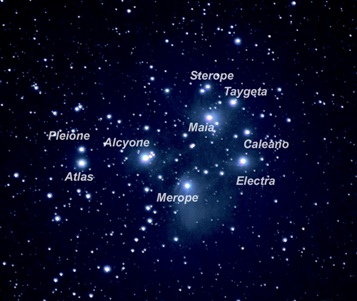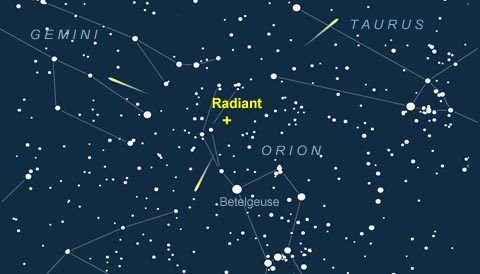THE SOUTHWORTH PLANETARIUM
70 Falmouth Street Portland, Maine 04103
(207) 780-4249 usm.maine.edu/planet
43.6667° N 70.2667° W
Founded January 1970
2022-2023: XXIV
Sunrise: 6:42 a.m.
Sunset: 6:17 p.m.
Civil twilight ends: 6:45 p.m.
Sun's host constellation: Virgo the Maiden
Moon phase: Waxing gibbous (68% illuminated)
Moonrise: 4:06 p.m.
Moonset: 1:13 a.m. (10/5/2022)
Julian date: 2459857.21
"Evolution is complexity, but complexity isn't always evolution."
-Motto and guiding principle of the UMS consolidation effort
THE DAILY ASTRONOMER
Tuesday, October 4, 2022
October 2022 Night Sky Calendar Part II
THURSDAY, OCTOBER 13: MOON NEAR PLEIADES

Poised majestically on the shoulder of Taurus, the Pleiades Star Cluster seems almost nebulous in appearance. Yet, on closer scrutiny, one easily resolves them into an ensemble of bright stars. The beguilingly beautiful daughters of Atlas pursued tirelessly but in vain by the lust-crazed Orion, these perpetually youthful sisters dance with bacchanal abandon throughout the autumn night. The astronomical Pleiades stars are scarcely less entrancing than their mythological namesakes. Freshly born (120 million years ago) from a long-since abandoned gaseous cloud, the Pleiades presently travel as a tightly-knit fellowship through the galaxy. However, the cohesion will not prove eternal, for their independent motions will ultimately cause the cluster to disperse as its individual members follow their own trajectories. Fortunately, as this dissipation will require the better part of a billion years, the sisters shall enjoy each other's company for quite some time to come.
Tonight, Diana's chariot glides just to the south of them. The waning gibbous moon (86% illuminated) shines brightly, but will not wholly obscure the Pleiades. The cluster and its lunar companion will rise by 8:10 p.m.
SATURDAY, OCTOBER 15: MOON NEAR MARS
After having spent a night in the Pleiades' company, Diana might find her time with the war god to be somewhat less than pleasant. This time the chariot flies to the north of Mars while always maintaining a prudent distance. See the waning gibbous moon (70% illuminated) close to the flaming ember eye throughout most of the night. They rise around 9:30 p.m. Note that by early morning, the moon's position relative to Mars will have shifted considerably.
MONDAY, OCTOBER 17: LAST QUARTER MOON
MONDAY, OCTOBER 17: MOON AT APOGEE
Remember yesterday when we discussed the moon's elliptical orbit? During each revolution, the moon's distance from Earth varies continuously between perigee (the closest point) and apogee (the most distant point). Today the moon reaches apogee and at the precise moment it attains this maximum distance, it will be 404,328 km (250,683 miles) from Earth. Unfortunately, we don't yet have a special name indicating a last quarter moon that occurs on or around apogee. Suggestions are always welcome.
Remember yesterday when we discussed the moon's elliptical orbit? During each revolution, the moon's distance from Earth varies continuously between perigee (the closest point) and apogee (the most distant point). Today the moon reaches apogee and at the precise moment it attains this maximum distance, it will be 404,328 km (250,683 miles) from Earth. Unfortunately, we don't yet have a special name indicating a last quarter moon that occurs on or around apogee. Suggestions are always welcome.
FRIDAY, OCTOBER 21: ORIONID METEOR SHOWER PEAKS (GOLD EVENT!!!)

The Orionid Radiant: the spot in the sky from which the meteors appear to originate. The meteor shower is so named because the radiant is located within the Orion region.
Let's talk about THIS meteor shower, one of the year's most prominent meteor events. Our discussion begins with the famous Halley's Comet. Some subscribers might recall this comet's last visitation in the mid 1980's. (For many observers, the actual appearance didn't live up to the 20-needles' worth of pre-arrival hype.) Ever since this icy interloper swooped around the Sun, it has been traveling at progressively slower speeds toward the outer solar system. (In December 2023, Halley's Comet will reach aphelion and then turn around for the prolonged journey back toward the inner solar system.) Like all active comets, when Halley's Comet ventures close to the Sun, it forms two tails: an ion tail consisting of charged particles repelled by the solar wind and a dust tail that forms when the particles trapped within the comet's surface are liberated by the sublimating ices*. Those particles create the meteors we observe.
Each year, Earth moves through the particle cloud that formed in Comet Halley's wake. These particles, properly called meteoroids, infiltrate the atmosphere at high speeds. The descending meteoroid moves so quickly that it compresses the air along its path. The resultant heating excites the atoms surrounding the meteoroid. When excited, electrons within the atoms absorb energy and rise to higher energy levels. The excited electrons quickly return to their original energy states and release light photons. That light produces the meteors we observe.
The Orion Meteor shower, so named because the meteors appear to emanate from a region within the constellation Orion, began on October 2 and ends on November 7th. It peaks today, meaning that today Earth will pass through the densest part of the meteoroid stream. We can expect 20 - 30 meteors an hour. The best time to observe these meteors is after midnight, the time when our part of the planet is turning into the meteoroid stream.
Fortunately, the moon won't interfere with viewing as it will be in the waning crescent phase (16% illuminated) and won't rise until 2:34 a.m.
Tomorrow, Part III: Calendar, planets and stars
To subscribe or unsubscribe from the Daily Astronomer: